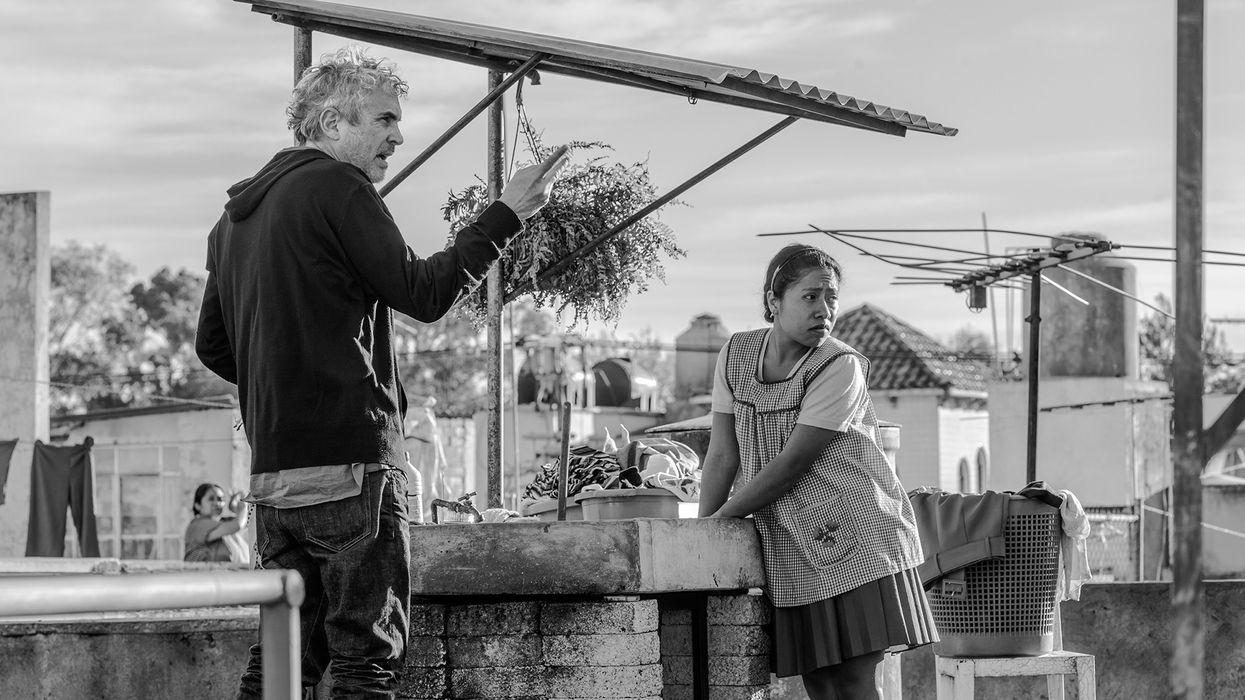Alfonso Cuarón and Emmanuel Lubezki Chat About the Cinematography of ‘Roma’
What we can learn when two filmmaking greats chat about the cinematography in Alfonso Cuarón’s ‘Roma’.

In case you’ve been living under a rock for the past several weeks, acclaimed filmmaker Alfonso Cuarón’s latest feature Roma was just released on Netflix and is building quite an Oscar buzz. Set in the 1970s in the “Colonia Roma” neighborhood of Mexico City, the semi-autobiographical take on Cuarón's upbringing follows Cleo, a live-in housekeeper to a middle-class family.
Written, directed and produced by Cuarón, the Mexican filmmaker also took a rare turn behind the camera as the film’s cinematographer. Originally, Cuarón’s frequent cinematographer collaborator Emmanuel Lubezki was slated to DP, but due to conflicts with Roma’s 100+ shoot day schedule, had to back out.
However, as Indiewire covered at a recent discussion screening at Raleigh Studios in Hollywood, the two filmmaking icons chatted about Roma and how Cuarón was able to shoot the film under the mantra: What would "Chivo" (Emmanuel Lubezki’s nickname) do?
Let’s look at some highlights from this discussion for some filmmaking and cinematography insights from these two masters.
On Shooting Black and White
Emmanuel Lubezki: Why black and white?
Alfonso Cuarón: I didn’t want a film that looks vintage, that looks old. I wanted to do a modern film that looks into the past. And you kept questioning me about black and white: “Maybe color is better, otherwise you’re going to look back.” That was your argument about the 65, because it brought a different unapologetic quality to the film. It’s not a vintage black and white. It’s a contemporary black and white. Black and white was part of the DNA of the film. When the idea manifested, it was about the character Cleo [Yalitza Aparicio], the tune was memory, and it was black and white. From there you can change things.
More insights into the filmography of Alfonso Cuarón:
- A Closer Look at the Incredible Cinematic Style of Alfonso Cuarón
- Chemistry and Intimacy with Alfonso Cuarón's Long Takes
- Watch: The Sounds of Alfonso Cuarón's Films
Finding the Space and Setting the Tempo
Emmanuel Lubezki: Something that was unlike “Children” and “Y Tu Mama” was the tempo. The camera is moving at a different tempo than the actors. It’s almost a complex jazz number. Are you describing it to the crew and they are doing it? What is the procedure?
Alfonso Cuarón: First is to find the space, when I start lensing, to go through the whole thing. Timing was the most difficult thing. People ask always about the beach scene. What was more complicated was simple things like doing a round movement, a 380 inside the house. When Cleo is turning off the lights we have 45 different camera positions, the camera can’t be in one place and panning. It was a floor with lines everywhere. Even before bringing in the actors it was about sorting out the timings. But the actors had to have the flexibility to improvise. Something I learned from you was communicating with the dolly or the operator.
Curveballs and Editing
Emmanuel Lubezki: Another contradiction from the book of filmmaking: you rehearse these complicated movements but some of the actors don’t know what’s coming. They didn’t read the script? They know the mechanics, but don’t know where the emotional turns are coming?
Alfonso Cuarón: They know some of the mechanics but not all of them. It was all the time changing; I was throwing them curveballs. The problem was editing, all the takes were so different. I’d choose something that was so great in context and the next moment find something that did not work. It was a domino effect. You had to go back to the first take and everything changed, the sense of timing and even information. Part of the challenge was a lot of the camera was static and characters moved around. It was more challenging when the camera was moving.
More insights into the filmography of Emmanuel Lubezki:
- Why Emmanuel Lubezki is One of the Best DPs of All Time
- A Primer on the Cinematic Techniques of 3-Time Oscar-Winning DP Emmanuel Lubezki
- Watch: A Visual Love Letter to 3-Time Oscar Winner Emmanuel Lubezki
What Would Chivo Do?
Emmanuel Lubezki: You were setting up the camera, talking to the actors. When did you have time to do the lighting?
Alfonso Cuarón: That was fundamental. We’re going to be in the dining room. I knew roughly the shot. From the night before we start doing pre-lights, having extra crew working extra hours to start doing a pre-rig, then I would finish. It was a process. Embracing being a cinematographer forced me to be on the set all day long. When we work together, we work, I go away. Somehow I had to be there, that was triggering more details of the memory of the moment, it was very useful. I was there lighting, and composing. For me, it was: “What would Chivo do?”
Have you seen Roma on Netflix yet? What are your thoughts on Cuarón’s cinematography and the film in general? Let us know in the comments below!
Source: Indiewire

















